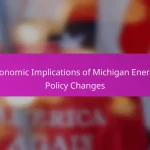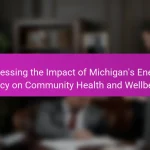
What are the key elements of successful energy policies in Michigan?
Key elements of successful energy policies in Michigan include renewable energy targets, energy efficiency programs, and regulatory frameworks. Renewable energy targets aim for a significant percentage of energy generation from renewable sources. For instance, Michigan’s goal is to achieve 50% renewable energy by 2030. Energy efficiency programs encourage reduced energy consumption through incentives for businesses and homeowners. The state has implemented programs that have saved billions in energy costs. Regulatory frameworks ensure compliance and support for both renewable energy and energy efficiency initiatives. These frameworks facilitate investments and provide clarity for stakeholders. Together, these elements contribute to a sustainable energy landscape in Michigan.
How do Michigan’s energy policies compare to those in other states?
Michigan’s energy policies emphasize renewable energy and energy efficiency. The state aims for 50% renewable energy by 2030, aligning with national trends. Compared to states like California, which targets 100% clean energy by 2045, Michigan’s goals are less aggressive. Michigan also has a strong focus on energy efficiency standards, similar to those in New York, which has implemented comprehensive energy efficiency programs. However, Michigan’s reliance on coal remains higher than in states like Massachusetts, which has significantly reduced coal usage. Overall, while Michigan shares some common goals with other states, its policies reflect a more moderate approach to energy transition.
What specific strategies have been implemented in Michigan’s energy policies?
Michigan’s energy policies have implemented several specific strategies. These include the promotion of renewable energy sources, such as wind and solar power. The state has set a goal of achieving 50% renewable energy by 2030. Energy efficiency programs have also been established to reduce consumption. The Clean and Renewable Energy Act supports these initiatives. Additionally, Michigan has invested in grid modernization to enhance energy distribution. The state encourages public-private partnerships to further develop energy infrastructure. Lastly, policies incentivize electric vehicle adoption to reduce carbon emissions.
How do these strategies align with national energy goals?
The strategies align with national energy goals by promoting renewable energy sources and enhancing energy efficiency. These strategies support the U.S. commitment to reduce greenhouse gas emissions by 50-52% by 2030, as outlined in the Paris Agreement. They also aim to achieve 100% carbon pollution-free electricity by 2035. By implementing these strategies, Michigan contributes to a nationwide transition toward sustainable energy systems. The state’s policies foster innovation in clean technologies, which is critical for meeting federal energy targets. Additionally, Michigan’s focus on local energy solutions strengthens energy resilience, aligning with national priorities for energy security.
What role do stakeholders play in shaping Michigan’s energy policies?
Stakeholders play a crucial role in shaping Michigan’s energy policies. They include government agencies, utility companies, environmental groups, and community organizations. These stakeholders engage in public consultations to express their interests and concerns. They influence policy decisions through advocacy and lobbying efforts. For instance, the Michigan Public Service Commission involves stakeholders in rulemaking processes. This ensures diverse perspectives are considered in energy planning. Additionally, stakeholder input can lead to innovative solutions in renewable energy initiatives. Their involvement helps balance economic, environmental, and social factors in policy development. Ultimately, stakeholders are essential in creating effective and sustainable energy policies in Michigan.
Who are the primary stakeholders involved in Michigan’s energy policy development?
The primary stakeholders involved in Michigan’s energy policy development include government agencies, utility companies, environmental organizations, and consumer advocacy groups. Government agencies, such as the Michigan Public Service Commission, regulate and oversee energy policies. Utility companies, including DTE Energy and Consumers Energy, play a crucial role in energy generation and distribution. Environmental organizations advocate for sustainable practices and renewable energy sources. Consumer advocacy groups represent the interests of residents and businesses regarding energy costs and reliability. These stakeholders collaborate to shape policies that address energy efficiency, renewable energy, and grid modernization in Michigan.
How do stakeholder interests influence policy outcomes?
Stakeholder interests significantly influence policy outcomes by shaping the priorities and decisions of policymakers. Stakeholders, including businesses, community groups, and government entities, advocate for their specific needs and concerns. Their engagement can lead to the inclusion of diverse perspectives in policy formulation. For instance, in Michigan, energy policies have been shaped by stakeholder input from utility companies and environmental organizations. This collaborative approach often results in policies that balance economic growth with environmental sustainability. Research shows that when stakeholders actively participate, policies are more likely to gain public support and achieve successful implementation.

What are some notable case studies of energy policy applications in Michigan?
Notable case studies of energy policy applications in Michigan include the state’s Renewable Portfolio Standard (RPS) and the implementation of the Clean Power Plan. The RPS mandates that utilities obtain a certain percentage of their energy from renewable sources. As of 2020, Michigan’s RPS requires 15% of energy from renewables. This policy has led to significant investments in wind and solar energy projects across the state.
Another case study is the Michigan Energy Efficiency Program. This program incentivizes energy-saving measures for residential and commercial buildings. Reports indicate that the program has saved over 1 billion kilowatt-hours annually. Additionally, the state’s commitment to reducing greenhouse gas emissions aligns with the goals outlined in the Clean Power Plan. Michigan aims to cut emissions from power plants by 26% by 2025.
These case studies demonstrate Michigan’s proactive approach to energy policy through regulations and programs that promote renewable energy and energy efficiency.
How have specific case studies demonstrated the effectiveness of energy policies?
Specific case studies have shown that energy policies can lead to significant improvements in energy efficiency and renewable energy adoption. For instance, Michigan’s Clean, Renewable and Efficient Energy Act has resulted in a 17% reduction in energy usage since its implementation. The state has also seen a 20% increase in renewable energy generation, primarily through wind and solar initiatives. These outcomes are supported by data from the Michigan Public Service Commission, which reported that energy efficiency programs saved consumers over $1 billion. Additionally, case studies from utility companies in Michigan demonstrate that energy policies have fostered job creation in the renewable sector, with over 60,000 jobs reported in 2020. These examples collectively illustrate the tangible benefits of well-structured energy policies in Michigan.
What lessons can be learned from the case study of renewable energy initiatives?
Renewable energy initiatives demonstrate several key lessons. First, collaboration among stakeholders is essential for success. In Michigan, partnerships between government, businesses, and communities have driven effective project implementation. Second, investment in technology can enhance efficiency and reduce costs. For instance, advancements in solar panel technology have made installations more accessible. Third, public education and awareness are crucial. Engaging communities helps garner support for renewable projects. Additionally, flexible policies allow for adaptation to changing circumstances. Michigan’s evolving energy policies reflect this adaptability. Finally, measuring outcomes is vital for continuous improvement. Tracking performance data informs future initiatives and policy adjustments.
How did energy efficiency programs impact local communities?
Energy efficiency programs positively impacted local communities by reducing energy costs and promoting sustainability. These programs led to a decrease in energy consumption, resulting in lower utility bills for residents. For instance, the Michigan Energy Efficiency Program reported that participating households saved an average of $300 annually. Additionally, these initiatives created local jobs in the energy sector. The programs also improved community health by reducing air pollution from energy production. Furthermore, they encouraged local businesses to adopt energy-saving practices, enhancing overall economic resilience. Overall, energy efficiency programs fostered a more sustainable and financially stable community environment.
What challenges were faced during the implementation of these energy policies?
Challenges during the implementation of Michigan’s energy policies included regulatory hurdles and funding limitations. Stakeholders faced difficulties navigating complex regulations. Limited financial resources hindered the deployment of necessary technologies. Public opposition often delayed project approvals. Coordination among various governmental levels proved challenging. Additionally, inconsistent policy enforcement created uncertainty for investors. These factors collectively impacted the effectiveness of the energy policies.
How did Michigan address opposition to energy policy changes?
Michigan addressed opposition to energy policy changes through stakeholder engagement and public consultations. The state organized forums to gather input from residents, businesses, and advocacy groups. These discussions aimed to address concerns and provide transparency in the policy-making process. Additionally, Michigan implemented pilot programs to showcase the benefits of new energy initiatives. This approach helped to build trust and demonstrate the effectiveness of proposed changes. As a result, the state was able to gain broader support for its energy policies.
What were the financial implications of these energy policy applications?
The financial implications of these energy policy applications included significant cost savings and increased investment in renewable energy. For instance, Michigan’s renewable energy standard led to a reduction in electricity prices by an estimated 10% over five years. Additionally, the policies attracted over $1 billion in private investments in clean energy projects. Job creation in the renewable sector surged, with approximately 25,000 new jobs reported since the implementation of these policies. Overall, these applications contributed to a more stable and sustainable energy market in Michigan.

What future trends can be anticipated for Michigan’s energy policy landscape?
Michigan’s energy policy landscape is expected to focus on renewable energy expansion and carbon reduction. The state aims to achieve a 50% reduction in greenhouse gas emissions by 2030. This aligns with the U.S. commitment to the Paris Agreement. Michigan’s utility companies are increasingly investing in solar and wind energy projects. The state is also enhancing energy efficiency programs for residential and commercial sectors. Legislative support for electric vehicle infrastructure is anticipated to grow. Additionally, community solar initiatives are likely to gain traction. These trends reflect a broader commitment to sustainable energy practices in Michigan.
How might emerging technologies influence Michigan’s energy policies?
Emerging technologies could significantly shape Michigan’s energy policies by enhancing efficiency and sustainability. Innovations such as smart grids enable real-time monitoring and management of energy consumption. This leads to reduced waste and optimized resource allocation. Additionally, advancements in renewable energy technologies, like solar and wind, can increase the state’s reliance on clean energy sources. According to the Michigan Energy Innovation Business Council, these technologies could create thousands of jobs while decreasing greenhouse gas emissions. Furthermore, energy storage solutions, such as battery systems, allow for better integration of renewable sources into the energy grid. This flexibility supports policy shifts towards more sustainable energy practices. Overall, emerging technologies are likely to drive Michigan towards more progressive and environmentally friendly energy policies.
What role will public opinion play in shaping future energy policies?
Public opinion will significantly influence future energy policies. Policymakers often consider public sentiment when drafting regulations. A 2021 survey by the Pew Research Center found that 79% of Americans support expanding renewable energy sources. This strong backing can lead to increased funding and legislative support for clean energy initiatives. Additionally, public advocacy can drive political leaders to prioritize climate action. Historical examples show that grassroots movements have successfully shaped energy policies, such as the push for Michigan’s renewable portfolio standards. Thus, public opinion serves as a crucial driver for energy policy development.
What best practices can be adopted from Michigan’s successful energy policy applications?
Michigan’s successful energy policy applications demonstrate several best practices. First, stakeholder engagement is crucial. Michigan actively involves communities and businesses in the decision-making process. This builds trust and ensures diverse perspectives are considered.
Second, data-driven policy formulation enhances effectiveness. Michigan utilizes comprehensive energy data to inform its strategies. This approach leads to targeted and efficient energy solutions.
Third, promoting renewable energy sources is essential. Michigan has invested in wind and solar energy initiatives. These efforts contribute to sustainable energy goals and reduce reliance on fossil fuels.
Additionally, energy efficiency programs are vital. Michigan implements programs that encourage residential and commercial energy-saving practices. This not only lowers energy consumption but also reduces costs for consumers.
Finally, regulatory support is necessary for success. Michigan’s policies provide a stable framework for energy investments. This attracts private sector participation and fosters innovation in energy technologies.
These best practices from Michigan’s energy policies can serve as a model for other regions aiming to enhance their energy strategies.
How can other states learn from Michigan’s approach to energy policy implementation?
Other states can learn from Michigan’s approach to energy policy implementation by adopting its comprehensive stakeholder engagement model. Michigan emphasizes collaboration among government agencies, utilities, and community organizations. This inclusive strategy ensures diverse perspectives are considered in policy development. Additionally, Michigan’s focus on renewable energy targets has driven significant investment in clean technologies. The state set a goal for 50% renewable energy by 2030, which encourages innovation and job creation. Furthermore, Michigan’s regulatory framework supports energy efficiency programs that have proven effective in reducing consumption. These programs have led to a reported savings of over 1.5 billion kilowatt-hours annually. By studying these elements, other states can enhance their own energy policies for greater effectiveness.
What are the key takeaways for policymakers aiming to replicate Michigan’s success?
Policymakers can replicate Michigan’s success by focusing on collaboration, innovation, and investment in clean energy. Building partnerships between government, industry, and academia fosters shared goals and resources. Michigan’s commitment to renewable energy sources has led to a significant reduction in carbon emissions. The state’s investment in energy efficiency programs has resulted in substantial cost savings for consumers. Additionally, creating incentives for clean technology development encourages local job growth. Policymakers should also prioritize public engagement to ensure community support for energy initiatives. Evidence from Michigan shows that these strategies can effectively drive sustainable energy transitions.
The main entity of this article is Michigan’s energy policy applications. The article provides an overview of successful strategies implemented in Michigan, highlighting key elements such as renewable energy targets, energy efficiency programs, and stakeholder engagement. It compares Michigan’s policies with those of other states, discusses the impact of specific case studies, and examines the role of stakeholders in shaping energy policies. Additionally, it outlines challenges faced during implementation, financial implications, and future trends in Michigan’s energy landscape, offering best practices and lessons learned for other states aiming to enhance their energy strategies.


